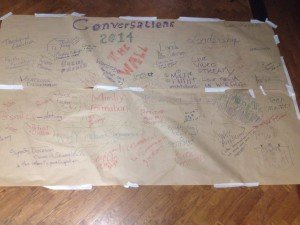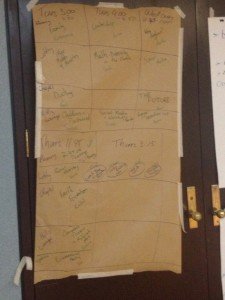This blog was originally published here.
It has been a blast over the past 6 months or so being part of the planning team of Conversation 2014: Clergy under 40 talk to God and each other. Being the first of it’s kind in the Anglican Church of Canada, and including many of our most recent ordinands, it was clear this was going to look different from our typical clergy conferences.
And that’s what I was excited about. Ask anyone and they will tell you I have never been to a conference I didn’t like. I am, though, starting to get a little bored with the processes-flipcharts, post-its, knee groups, speakers all starting to look and sound the same, knowing that someone somewhere was expecting something out of me but not always knowing what it was.
In 2011 I attended my first unconference, UNCO, at Stony Point Retreat Centre in NY. We used a model called open space (you can read more about it here) which meant I was given no agenda before I arrived, no list of workshop topics, no biographies of speakers with professional photos; just church leaders meeting in a space to have some conversations. I also attended in 2013 and then started using open space technology in some settings here in Canada.
Conversations 2014 came along and it seemed we all wanted the same thing, “We’re going to be working together for a long time (God willing!)–so let’s get to know each other”. Simply providing a schedule of conversations and leaving the content up to the group is what we came up with.
Even though I am a huge fan of this model, it always comes with anxiety. What do we report back? How do we make sure we cover everything? If I was asked how we made the decision to this route, I would say, “We decided to trust…no, not trust the process! We decided to trust one another.”
 So, how did it work? It began with The Wall, both virtual and physical. A few weeks before the conference we used our facebook group and the event page to start sharing possible discussion topics. It ranged from social media in the parish to clergy families to land and buildings to the relevance of mid-week masses. All these topics were added to a physical wall–butcher paper on the wall of Fulford Hall. As we arrived we added to the wall.
So, how did it work? It began with The Wall, both virtual and physical. A few weeks before the conference we used our facebook group and the event page to start sharing possible discussion topics. It ranged from social media in the parish to clergy families to land and buildings to the relevance of mid-week masses. All these topics were added to a physical wall–butcher paper on the wall of Fulford Hall. As we arrived we added to the wall.
 On Tuesday afternoon, we started to fill in the schedule. Out of everything on the wall, we scheduled several conversations. Unlike a typical distilling process where you look for themes and try to include everything in broad conversations, we honoured each topic’s right to have it’s own conversation and were limited only by meeting space, and thanks to the generousity of the Diocese of Montreal, even that was almost limitless. Some topics were easily shared with others, but many stood alone. Some conversations had over 20 participants, some only 3 or 4. “36 people worked out an entire conference agenda in an hour and a quarter?” Well, with a frame, but yes, yes we did!
On Tuesday afternoon, we started to fill in the schedule. Out of everything on the wall, we scheduled several conversations. Unlike a typical distilling process where you look for themes and try to include everything in broad conversations, we honoured each topic’s right to have it’s own conversation and were limited only by meeting space, and thanks to the generousity of the Diocese of Montreal, even that was almost limitless. Some topics were easily shared with others, but many stood alone. Some conversations had over 20 participants, some only 3 or 4. “36 people worked out an entire conference agenda in an hour and a quarter?” Well, with a frame, but yes, yes we did!
Most of the content of Tuesday, Wednesday and Thursday consisted of these small groups with a few plenary check-ins to explore emerging themes. By Thursday, the last conference day, some ideas for further work started to emerge. Some were conversations that may continue in our own dioceses, among other young clergy, or in our parishes. Some were actual projects that a few will work on together.
For example, I participated in many conversations, not just during the scheduled small groups but at meal times and in the evenings, about clergy and mental health. I talk a really good game about mental health and boundaries, but I also cave to pressure from a wider church that says, “You have more than anyone before you, so stop complaining”. But what if it is still inadequate to deal with the stress this vocation has on our mental health? What about the stigma that keeps clergy from talking about our own mental illness within our college for fear of repurcussion? Why do we continue to increase benefits for eyecare, prescriptions and dental care but our psychotherapy benefit remains at $300 a year in a profession where it is recommended we be in a regular therapeutic relationship, no matter how mentally healthy we are? I want to have this conversation with the wider church. This would never have emerged for me without the freedom of uncovering content with this incredible group of people.
There is much more to come out of this conference. I’ll reblog what I can, and, eventually, these posts from participants will appear in one place. Stay tuned. In the meantime, if want to have a conversation, here’s a wall to get it started.
